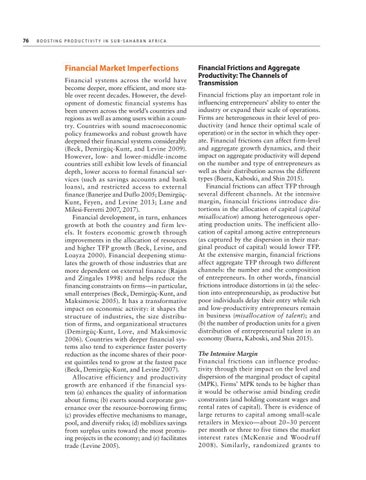76 B o o s t i n g
P r o d u c t i v i t y i n S u b - Sa h a r a n A f r i ca
Financial Market Imperfections Financial systems across the world have become deeper, more efficient, and more stable over recent decades. However, the development of domestic financial systems has been uneven across the world’s countries and regions as well as among users within a country. Countries with sound macroeconomic policy frameworks and robust growth have deepened their financial systems considerably (Beck, Demirgüç-Kunt, and Levine 2009). However, low- and lower-middle-income countries still exhibit low levels of financial depth, lower access to formal financial services (such as savings accounts and bank loans), and restricted access to external finance (Banerjee and Duflo 2005; DemirgüçKunt, Feyen, and Levine 2013; Lane and Milesi-Ferretti 2007, 2017). Financial development, in turn, enhances growth at both the country and firm levels. It fosters economic growth through improvements in the allocation of resources and higher TFP growth (Beck, Levine, and Loayza 2000). Financial deepening stimulates the growth of those industries that are more dependent on external finance (Rajan and Zingales 1998) and helps reduce the financing constraints on firms—in particular, small enterprises (Beck, Demirgüç-Kunt, and Maksimovic 2005). It has a transformative impact on economic activity: it shapes the structure of industries, the size distribution of firms, and organizational structures (Demirgüç-Kunt, Love, and Maksimovic 2006). Countries with deeper financial systems also tend to experience faster poverty reduction as the income shares of their poorest quintiles tend to grow at the fastest pace (Beck, Demirgüç-Kunt, and Levine 2007). Allocative efficiency and productivity growth are enhanced if the financial system (a) enhances the quality of information about firms; (b) exerts sound corporate governance over the resource-borrowing firms; (c) provides effective mechanisms to manage, pool, and diversify risks; (d) mobilizes savings from surplus units toward the most promising projects in the economy; and (e) facilitates trade (Levine 2005).
Financial Frictions and Aggregate Productivity: The Channels of Transmission Financial frictions play an important role in influencing entrepreneurs’ ability to enter the industry or expand their scale of operations. Firms are heterogeneous in their level of productivity (and hence their optimal scale of operation) or in the sector in which they operate. Financial frictions can affect firm-level and aggregate growth dynamics, and their impact on aggregate productivity will depend on the number and type of entrepreneurs as well as their distribution across the different types (Buera, Kaboski, and Shin 2015). Financial frictions can affect TFP through several different channels. At the intensive margin, financial frictions introduce distortions in the allocation of capital (capital misallocation) among heterogeneous operating production units. The inefficient allocation of capital among active entrepreneurs (as captured by the dispersion in their marginal product of capital) would lower TFP. At the extensive margin, financial frictions affect aggregate TFP through two different channels: the number and the composition of entrepreneurs. In other words, financial frictions introduce distortions in (a) the selection into entrepreneurship, as productive but poor individuals delay their entry while rich and low-productivity entrepreneurs remain in business (misallocation of talent); and (b) the number of production units for a given distribution of entrepreneurial talent in an economy (Buera, Kaboski, and Shin 2015). The Intensive Margin Financial frictions can influence productivity through their impact on the level and dispersion of the marginal product of capital (MPK). Firms’ MPK tends to be higher than it would be otherwise amid binding credit constraints (and holding constant wages and rental rates of capital). There is evidence of large returns to capital among small-scale retailers in Mexico—about 20–30 percent per month or three to five times the market interest rates (McKenzie and Woodruff 2008). Similarly, randomized grants to



